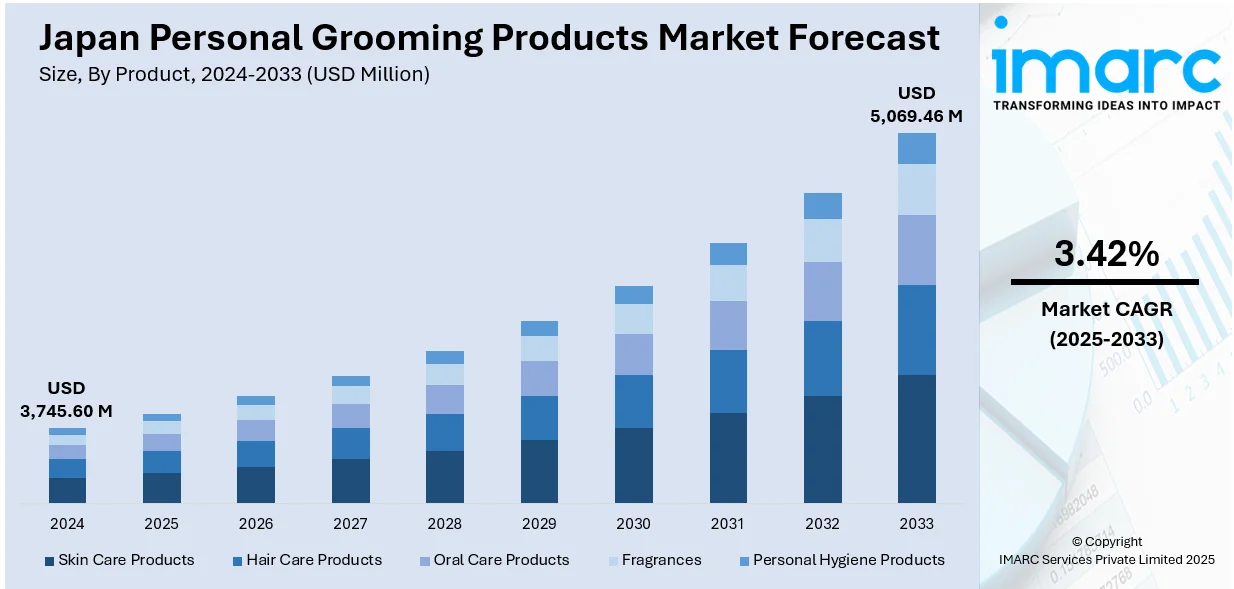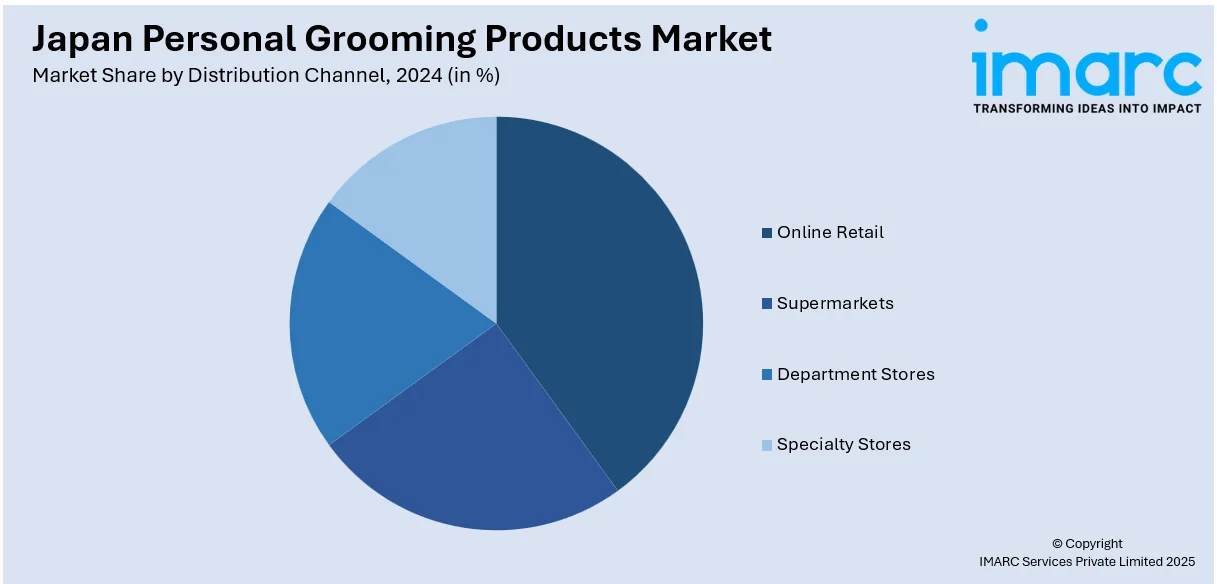
Japan Personal Grooming Products Market Size, Share, Trends and Forecast by Product, Gender, Distribution Channel, Form, and Region, 2025-2033
Japan Personal Grooming Products Market Overview:
The Japan personal grooming products market size reached USD 3,745.60 Million in 2024. Looking forward, IMARC Group expects the market to reach USD 5,069.46 Million by 2033, exhibiting a growth rate (CAGR) of 3.42% during 2025-2033. The market is driven by the country's aging population, causing demand for products dedicated to healthy skin and well-being. Heightened environmental consciousness has also encouraged people to look for green grooming products, and subsequently, demand for products created from natural resources and packaged in minimal waste has increased. Growth of digital platforms and social media has been a major contributor to influencing consumer tastes, with online tutorials, influencer marketing, and e-commerce websites offering consumers greater ease of access to product information and purchasing channels, further increasing the Japan personal grooming products market share.
|
Report Attribute
|
Key Statistics
|
|---|---|
|
Base Year
|
2024
|
|
Forecast Years
|
2025-2033
|
|
Historical Years
|
2019-2024
|
| Market Size in 2024 | USD 3,745.60 Million |
| Market Forecast in 2033 | USD 5,069.46 Million |
| Market Growth Rate 2025-2033 | 3.42% |
Japan Personal Grooming Products Market Trends:
Focus on Natural and Clean Beauty Products
There is an increasing desire for natural, organic, and chemical-free personal grooming products in Japan. Consumers are becoming more sophisticated regarding the ingredients used in their grooming products and are seeking products that reflect their health and environmental concerns. This movement can be seen in the success of skincare items that use authentic Japanese ingredients like rice water, green tea, and seaweed for their positive benefits. Companies are moving to create products that highlight transparency, sustainability, and simplicity in terms of packaging, targeting the sophisticated Japanese consumer. The movement towards clean beauty is a larger cultural shift toward wellness and mindfulness and is shaping the purchase decision and brand loyalty.

To get more information on this market, Request Sample
Technology Integration in Grooming Habits
Japanese consumers are adopting technology to make personal grooming habits better, and as a result, smart grooming devices and artificial intelligence-based skincare products are on the increase. Technologies like facial recognition technology that offers customized skincare advice and smart razors that adapt to skin shape are in high demand. These technologies address the population's need for precision and customization in grooming habits as a result of their affinity for technology. In addition, the consolidation of virtual consultations and online channels provides consumers with easy access to expert opinion and product knowledge, making it a further push in the use of technology for personal grooming. This development is a testament to Japan's leadership in innovation while merging traditional heritage and innovation, which further contributes to the Japan personal grooming products market growth.
Impact of Aging Population on Grooming Preferences
Japan's aging population is having a deep impact on the personal grooming products market, with a strong change toward product coverage for mature skin and well-being. Mature consumers are looking for grooming products that help with specific issues like skin elasticity, moisture, and anti-aging. Brands are reacting by creating niche products that include ingredients that are recognized for their rejuvenating functions, including collagen and hyaluronic acid. Moreover, inclusive marketing and product accessibility are gaining more attention as there is a need to make grooming solutions accessible to everyone across all age brackets. This age change is encouraging businesses to get innovative and modify their products to address Japan's changing needs as an aging population, underlining the significance of inclusivity and focused solutions in the personal grooming space.
Japan Personal Grooming Products Market Segmentation:
IMARC Group provides an analysis of the key trends in each segment of the market, along with forecasts at the country and regional levels for 2025-2033. Our report has categorized the market based on product, gender, distribution channel, and form.
Product Insights:
- Skin Care Products
- Hair Care Products
- Oral Care Products
- Fragrances
- Personal Hygiene Products
The report has provided a detailed breakup and analysis of the market based on the product. This includes skin care products, hair care products, oral care products, fragrances, and personal hygiene products.
Gender Insights:
- Men
- Women
- Unisex
A detailed breakup and analysis of the market based on the gender has also been provided in the report. This includes men, women, and unisex.
Distribution Channel Insights:

- Online Retail
- Supermarkets
- Department Stores
- Specialty Stores
The report has provided a detailed breakup and analysis of the market based on the distribution channel. This includes online retail, supermarkets, department stores, and specialty stores.
Form Insights:
- Liquid
- Cream
- Gel
- Spray
- Wipes
A detailed breakup and analysis of the market based on the form has also been provided in the report. This includes liquid, cream, gel, spray, and wipes.
Regional Insights:
- Kanto Region
- Kansai/Kinki Region
- Central /Chubu Region
- Kyushu-Okinawa Region
- Tohoku Region
- Chugoku Region
- Hokkaido Region
- Shikoku Region
The report has also provided a comprehensive analysis of all the major regional markets, which include Kanto Region, Kansai/Kinki Region, Central /Chubu Region, Kyushu-Okinawa Region, Tohoku Region, Chugoku Region, Hokkaido Region, and Shikoku Region.
Competitive Landscape:
The market research report has also provided a comprehensive analysis of the competitive landscape. Competitive analysis such as market structure, key player positioning, top winning strategies, competitive dashboard, and company evaluation quadrant has been covered in the report. Also, detailed profiles of all major companies have been provided.
Japan Personal Grooming Products Market News:
- In June 2024, Kao Corporation revealed it aims to enhance its presence in the men's hair care market with additional premium offerings influenced by the hair and scalp skinification trend. The men's grooming line Success from the company has introduced Success RESIL, offering two products shampoo and conditioner that feature plant-based amino acids in silicone-free formulations.
Japan Personal Grooming Products Market Report Coverage:
| Report Features | Details |
|---|---|
| Base Year of the Analysis | 2024 |
| Historical Period | 2019-2024 |
| Forecast Period | 2025-2033 |
| Units | Million USD |
| Scope of the Report |
Exploration of Historical Trends and Market Outlook, Industry Catalysts and Challenges, Segment-Wise Historical and Future Market Assessment:
|
| Products Covered | Skin Care Products, Hair Care Products, Oral Care Products, Fragrances, Personal Hygiene Products |
| Genders Covered | Men, Women, Unisex |
| Distribution Channels Covered | Online Retail, Supermarkets, Department Stores, Specialty Stores |
| Forms Covered | Liquid, Cream, Gel, Spray, Wipes |
| Regions Covered | Kanto Region, Kansai/Kinki Region, Central /Chubu Region, Kyushu-Okinawa Region, Tohoku Region, Chugoku Region, Hokkaido Region, Shikoku Region |
| Customization Scope | 10% Free Customization |
| Post-Sale Analyst Support | 10-12 Weeks |
| Delivery Format | PDF and Excel through Email (We can also provide the editable version of the report in PPT/Word format on special request) |
Key Questions Answered in This Report:
- How has the Japan personal grooming products market performed so far and how will it perform in the coming years?
- What is the breakup of the Japan personal grooming products market on the basis of product?
- What is the breakup of the Japan personal grooming products market on the basis of gender?
- What is the breakup of the Japan personal grooming products market on the basis of distribution channel?
- What is the breakup of the Japan personal grooming products market on the basis of form?
- What is the breakup of the Japan personal grooming products market on the basis of region?
- What are the various stages in the value chain of the Japan personal grooming products market?
- What are the key driving factors and challenges in the Japan personal grooming products market?
- What is the structure of the Japan personal grooming products market and who are the key players?
- What is the degree of competition in the Japan personal grooming products market?
Key Benefits for Stakeholders:
- IMARC’s industry report offers a comprehensive quantitative analysis of various market segments, historical and current market trends, market forecasts, and dynamics of the Japan personal grooming products market from 2019-2033.
- The research report provides the latest information on the market drivers, challenges, and opportunities in the Japan personal grooming products market.
- Porter's five forces analysis assist stakeholders in assessing the impact of new entrants, competitive rivalry, supplier power, buyer power, and the threat of substitution. It helps stakeholders to analyze the level of competition within the Japan personal grooming products industry and its attractiveness.
- Competitive landscape allows stakeholders to understand their competitive environment and provides an insight into the current positions of key players in the market.
Need more help?
- Speak to our experienced analysts for insights on the current market scenarios.
- Include additional segments and countries to customize the report as per your requirement.
- Gain an unparalleled competitive advantage in your domain by understanding how to utilize the report and positively impacting your operations and revenue.
- For further assistance, please connect with our analysts.
 Request Customization
Request Customization
 Speak to an Analyst
Speak to an Analyst
 Request Brochure
Request Brochure
 Inquire Before Buying
Inquire Before Buying




.webp)




.webp)












